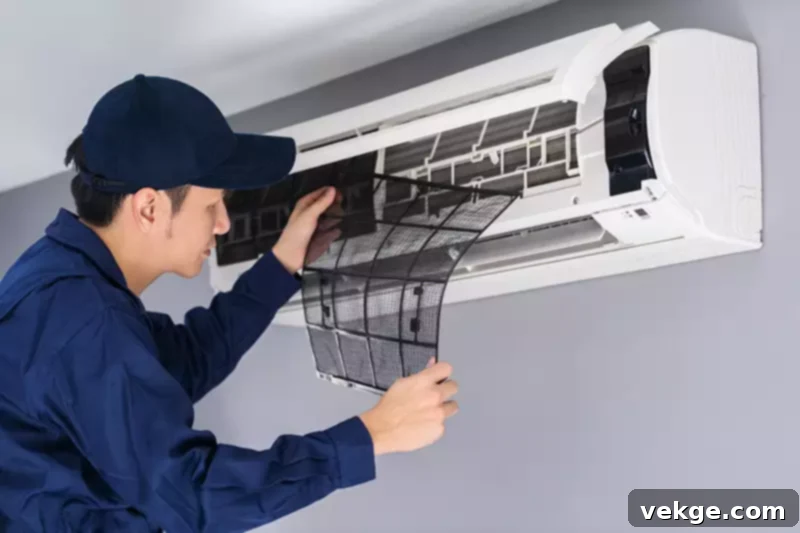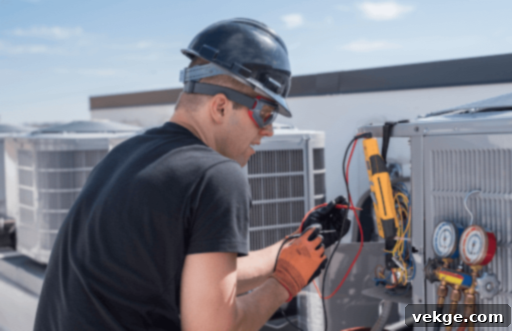Ultimate Fall HVAC Maintenance Guide: Prepare Your Home for Winter Warmth and Efficiency
As the vibrant colors of autumn begin to emerge, signaling the transition from warm summer days to crisp, cool evenings, it’s a critical time to turn your attention to your home’s heating, ventilation, and air conditioning (HVAC) system. Proper fall HVAC maintenance isn’t just about ensuring your home stays comfortably warm; it’s a strategic investment in energy efficiency, system longevity, and the prevention of inconvenient and costly breakdowns during the peak heating season. By taking proactive steps now, you can safeguard your home’s comfort, improve indoor air quality, and enjoy significant savings on your utility bills. This comprehensive guide outlines the essential HVAC maintenance tips to prepare your system for the demands of fall and the approaching winter.
Inspect and Replace Air Filters for Optimal Performance

One of the most straightforward yet impactful steps in maintaining your HVAC system is the regular inspection and replacement of air filters. Throughout the year, your HVAC system tirelessly circulates air, and in doing so, its filters act as a crucial barrier, trapping dust, dirt, pet dander, pollen, and other airborne particulates. As fall approaches, the accumulation of these contaminants can lead to severely clogged filters. This blockage restricts airflow, forcing your HVAC system to work considerably harder to push air through, thereby increasing energy consumption and decreasing overall efficiency.
Neglecting this simple task can have several adverse effects. A dirty filter not only compromises your system’s performance but also significantly degrades indoor air quality, which is particularly important during fall when new allergens like mold spores and lingering pollen can be prevalent. Furthermore, a system struggling against a blocked filter is more prone to premature wear and tear on vital components, potentially leading to expensive repairs down the line. Replacing your air filter every 1-3 months, or more frequently if you have pets or allergies, is a habit that pays dividends. Fall presents an ideal window to check and replace your filters, ensuring your system operates at peak efficiency as it transitions from cooling to heating, and helping to maintain a healthier indoor environment.
Thoroughly Clean the Outdoor Unit: A Crucial Step
The outdoor unit, or condenser, of your HVAC system works hard throughout the summer, often becoming a collection point for various types of outdoor debris. Leaves, twigs, grass clippings, dirt, and even spiderwebs can accumulate around and inside the unit. Before the cooler autumn weather firmly sets in, a thorough cleaning of this outdoor component is essential. This preparation ensures proper airflow, which is vital for the system’s efficient operation, and prevents potential issues like overheating or complete malfunction.
To begin, always ensure the power to your outdoor unit is completely turned off at the main electrical panel to prevent any accidental startup. Carefully remove any visible debris, such as leaves or grass, from around the unit. Using a soft brush or a vacuum cleaner with a brush attachment, gently clean the delicate condenser coils. These coils are responsible for heat exchange, and any buildup of dirt or grime can significantly impede their ability to perform efficiently. Additionally, trim back any vegetation, such as shrubs or tall grasses, that may be growing too close to the unit. Maintaining at least two feet of clear space around the outdoor unit allows for unrestricted airflow, which is critical for the system to dissipate heat effectively in the cooling season and absorb it efficiently in the heating season. This simple act of cleaning and clearing enhances the system’s efficiency and helps extend its operational lifespan.
Test the Heating Function Before Winter Arrives
After months of dormancy during the warmer seasons, your heating system might need a gentle reintroduction to active duty. Before the biting cold of winter truly settles in, it’s a wise practice to test your heating function. This proactive step allows you to identify any potential issues early, providing ample time for repairs without the inconvenience of a heating breakdown when you need it most.
To test, simply switch your thermostat from ‘cool’ to ‘heat’ mode and set the temperature a few degrees higher than the current room temperature. Listen carefully for the system to kick on. Pay close attention to any unusual sounds, such as grinding, clanking, whistling, or banging, which could indicate a mechanical problem. Also, be mindful of any strange smells. While a slight burning dust smell is common when the heater is first activated (as accumulated dust burns off), persistent or strong odors—especially those resembling burning plastic, electrical smells, or rotten eggs (which could signal a gas leak)—warrant immediate investigation and professional attention. Confirm that warm air is consistently blowing from all your vents and that the system responds accurately to thermostat adjustments. Addressing minor issues now can prevent them from escalating into major, costly repairs or emergency situations when temperatures drop.
Schedule a Professional HVAC Inspection for Comprehensive Care

While DIY maintenance tasks are invaluable, certain critical components of your HVAC system demand the expertise of a certified professional. Scheduling an annual HVAC inspection, ideally during the fall, is paramount to ensuring your system is in optimal condition before the cold weather sets in. A professional technician possesses the specialized knowledge and tools to identify subtle issues that might go unnoticed by an untrained eye, preventing minor problems from escalating into major system failures.
During a comprehensive inspection, a technician will perform a multi-point check, including but not limited to: verifying refrigerant levels, inspecting electrical connections for safety and wear, lubricating moving parts, cleaning and inspecting the evaporator and condenser coils, checking the thermostat for accuracy, examining the heat exchanger for cracks (which can lead to dangerous carbon monoxide leaks), and testing all safety controls. They will also assess the overall system efficiency and provide recommendations for any necessary repairs or adjustments.
For residents seeking reliable and experienced HVAC services, companies like Apple Plumbing Heating & Air offer a full spectrum of plumbing and HVAC solutions with decades of industry experience. Their certified service technicians undergo extensive training to proficiently operate, diagnose, and repair every intricate component of your HVAC system, ensuring peak performance and reliability. By entrusting your system to a professional, you gain peace of mind knowing that all potential issues, from defective parts to electrical inefficiencies, are addressed proactively. This professional oversight not only enhances your system’s safety and extends its lifespan but also ensures it’s fully prepared to meet the rigorous demands of the fall and winter seasons, providing consistent comfort and energy efficiency throughout your home.
Clean and Clear Vents and Registers for Even Heat Distribution
The efficiency of your HVAC system isn’t solely dependent on the furnace or air conditioner; the pathways through which conditioned air travels are equally important. Over time, the vents and registers located throughout your home can accumulate significant amounts of dust, dirt, and pet hair. This buildup creates blockages that restrict proper airflow, forcing your HVAC system to work harder to distribute air and ultimately reducing its overall efficiency and your comfort.
As fall arrives and you prepare to rely more heavily on your heating system, it’s essential to give these vents and registers a thorough cleaning. Use a vacuum cleaner with a brush attachment to remove dust and debris from both the grilles and as far into the ductwork as you can reach. Beyond cleaning, take a moment to assess the placement of furniture, rugs, or other household items. Ensure that nothing is obstructing the airflow from any vent or return air register. Blocked vents can lead to uneven heating, creating cold spots in some rooms and overheating others, which then prompts you to adjust the thermostat unnecessarily, wasting energy. Keeping all vents and registers clear helps your system distribute warm air more evenly and efficiently throughout your home, preventing it from overworking and ensuring consistent comfort.
Inspect and Clean the Blower Motor for Efficient Air Circulation
The blower motor is the heart of your HVAC system’s air distribution. Its primary function is to circulate conditioned air—be it warm or cool—throughout your home’s ductwork. As highlighted by the U.S. Department of Energy, common furnace blowers often operate at a mere 10% to 15% efficiency, underscoring the critical need for improvements in motor design and fan aerodynamics. This also emphasizes why maintaining existing blower motors in pristine condition is so vital.
Over time, dust, lint, and other debris can accumulate on the blower motor and its fan blades. This buildup acts as an insulator, causing the motor to run hotter and work harder, which drastically reduces its efficiency and can shorten its lifespan. A dirty blower motor can lead to reduced airflow, uneven heating, and increased energy consumption. Fall is an opportune time to inspect the blower motor. If you feel comfortable, you can gently clean the blades with a soft brush or cloth after ensuring the power to the unit is off. However, this is often a task best left to a professional, especially if the motor is difficult to access or requires more intricate cleaning.
If you notice any unusual noises emanating from the blower area, such as squealing or grinding, or if you perceive a significant reduction in airflow from your vents, these are strong indicators that the blower motor may require professional inspection or repair. A well-maintained and clean blower motor ensures that your HVAC system can effectively distribute heat, providing consistent and reliable comfort throughout your entire home during the colder months.
Clear the Drain Lines to Prevent Water Damage and Malfunctions
While often overlooked, the drain lines of your HVAC system play a crucial role, particularly in systems that also handle cooling. These lines are responsible for safely expelling condensation that forms during the cooling process. However, over time, these lines can become breeding grounds for algae, mold, and other biological growth, leading to blockages. When drain lines are clogged, the accumulated moisture has nowhere to go. This can result in water backing up into the unit, potentially causing system malfunctions, triggering safety shut-offs, or, more severely, leading to water damage in your home’s ceiling, walls, or surrounding areas.
Even if you’ve primarily used your system for cooling during the summer, checking and clearing these drain lines in the fall is a vital preparatory step. A blocked drain line can also create excessive humidity within the system, fostering mold growth and impacting indoor air quality. For many homeowners, a simple maintenance task involves pouring a cup of distilled white vinegar down the access port of the condensate drain line every few months to inhibit biological growth. If you observe standing water near your outdoor unit or in the condensate pan, or if your system frequently shuts down, it’s a clear sign of a clogged drain line that requires immediate attention. Keeping these lines clear not only prevents costly repairs related to water damage and system failure but also ensures your HVAC system maintains optimal efficiency, ready to handle the varying demands of the upcoming fall and winter seasons without unexpected interruptions.
By diligently following these comprehensive fall HVAC maintenance tips, you are not just preparing your heating and cooling system for the colder months; you are making a proactive investment in your home’s comfort, safety, and long-term energy efficiency. Regular upkeep extends the lifespan of your valuable HVAC equipment, minimizes the risk of inconvenient breakdowns, and helps keep your energy bills in check. Don’t wait for the first cold snap to discover a problem; take these steps now to ensure a warm, comfortable, and worry-free autumn and winter season.
